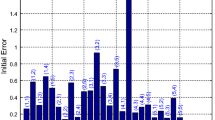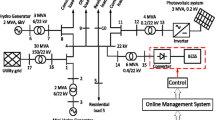Abstract
In the emerging restructured power system, the congestion management (CM) has become extremely important in order to ensure the security and reliability of the system. In addition to this, lack of CM can impose a hindrance in electricity trading. This paper presents a novel, growing radial basis function neural network (GRBFNN)-based approach for CM. For achieving CM, Nodal congestion price (NCP) forecasting is performed in real time competitive power market. NCP forecasting is an effective way of price-based preventive CM as it directly indicates the presence as well as the severity of the congestion in the system. In present paper, GRBFNN has been developed for NCP forecasting dividing the whole power system into various congestion zones. An unsupervised learning vector quantization (VQ) clustering algorithm is applied as feature selection technique for the developed GRBFNN and for partitioning the power system into different congestion zones. For each congestion zone a separate neural network has been developed to ensure faster training and accurate forecasting results. The proposed approach of CM is implemented on an RTS 24-bus system. The results obtained are compared with a different constructive algorithm-based RBF network called as general regression neural network (GRNN) and two back-propagation algorithms based ANNs. Comparison results show that proposed GRBFNN is more computationally efficient with better predictive ability.







Similar content being viewed by others
Abbreviations
- \( C_{{{\text{S}}_{{_{i} }} }} \) :
-
supply bid of unit i in $/MWh
- \( C_{{{\text{D}}_{j} }} \) :
-
demand bid of unit j in $/MWh
- \( P_{{{\text{S}}_{i} }} \) :
-
supply bid volume of unit i in MW
- \( P_{{{\text{D}}_{j} }} \) :
-
demand bid volume of unit j in MW
- \( P_{{{\text{S}}_{{\max_{i} }} }} \) :
-
upper limit of supply bid volume of unit i in MW
- \( P_{{{\text{S}}_{{\min_{i} }} }} \) :
-
lower limit of supply bid volume of unit i in MW
- \( P_{{{\text{D}}_{{\max_{j} }} }} \) :
-
upper limit of demand bid volume of unit j in MW
- \( P_{{{\text{D}}_{{\min_{j} }} }} \) :
-
lower limit of demand bid volume of unit j in MW
- \( Q_{{{\text{G}}_{i} }} \) :
-
reactive power output of unit i in MVAr
- \( Q_{{{\text{G}}_{{\min_{i} }} }} \) :
-
upper limit of reactive power at unit i in MVAr
- \( Q_{{{\text{G}}_{{\max_{i} }} }} \) :
-
lower limit of reactive power at unit i in MVAr
- V k :
-
voltage magnitude at node k in pu
- \( V_{{\min_{k} }} \) :
-
lower limit of voltage magnitude at node k in pu
- \( V_{{\max_{k} }} \) :
-
upper limit of voltage magnitude at node k in pu
- I mk :
-
line currents between nodes m and k in pu
- \( I_{{mk_{\max } }} \) :
-
upper limit of line current between nodes m and k
- P mk :
-
real power flow between nodes m and k
- \( P_{{mk_{\max } }} \) :
-
upper limit of real power flow through line between nodes m and k
- P k :
-
net real power injected at bus k in MW
References
Crause T (2001) Congestion management in liberalized electricity markets—theoretical concepts and international application. EEH Power System Laboratory Swiss Federal Institute of Technology Zurich. http://www.eeh.ee.ethz.ch/downloads/psl/publications/krause_congestion_management.pdf
Talukdar BK, Sinha AK, Mukhopadhyay S, Bose A (2005) A computationally simple method for cost-efficient generation rescheduling and load shedding for congestion management. Int J Electr Power Energy Syst 27:379–388. doi:10.1016/j.ijepes.2005.02.003
Granelli G, Montagna M, Zanellini F, Bresesti P, Vailati R, Innorta M (2006) Optimal network reconfiguration for congestion management by deterministic and genetic algorithms. Electr Power Syst Res 76:549–556. doi:10.1016/j.epsr.2005.09.014
Tuan LA, Bhattacharya K, Daalder J (2005) Transmission congestion management in bilateral markets: an interruptible load auction solution. Electr Power Syst Res 74:379–389. doi:10.1016/j.epsr.2004.11.010
Kristiansen T (2004) Congestion management, transmission pricing and area price hedging in the Nordic region. Int J Electr Power Energy Syst 26:685–695. doi:10.1016/j.ijepes.2004.05.004
Xie K, Song YH, Stonham J, Yu E, Liu G (2000) Decomposition model and interior point methods for optimal spot pricing of electricity in deregulation environments. IEEE Trans Power Syst 15:39–50. doi:10.1109/59.852099
Gil HA, Galiana FD, Da Silva EL (2006) Nodal price control: a mechanism for transmission network cost allocation. IEEE Trans Power Syst 21:3–10. doi:10.1109/TPWRS.2005.861990
Schweppe FC, Cramanis M, Taboras R, Bohn R (1988) Spot pricing of electricity, Appendix D. Kluwer, Norwell
Pandey SN, Tapaswi S, Srivastava L (2008) Nodal congestion price estimation in spot power market using artificial neural network. IET Proc Gener Trans Distrib 2:280–290. doi:10.1049/iet-gtd:20070309
Szkuta R, Sanabria LA, Dillon TS (1999) Electricity price short-term forecasting using artificial neural networks. IEEE Trans Power Syst 14:851–857. doi:10.1109/59.780895
Yang H, Zhou R, Liu J (2005) A RBFN hierarchical clustering-based network partitioning method for zonal pricing. In: Proceedings of the 2nd International Conference on Electrical and Elex Engineering. Mexico, pp 282–285
Zhang B, Zeng C, Wang S, Xie P (2004) Forecasting market-clearing price in day-ahead market, using SOM-ANN. In: Proceedings of 39th International Universities Power Engineering Conference (UPEC), pp 390–393
Karayiannis NB (2002) Soft learning vector quantization and clustering algorithms based on mean type aggregation operators. Int J Fuzzy Syst 4(3)
Rajasekaran S, Pai GAV (2006) Neural networks, fuzzy logic and genetic algorithms–synthesis and applications. Prentice-Hall of India Private Limited, New Delhi
Platt J (1991) A resource allocating network for function interpolation. Neural Comput 3:213–225
Fritzke B (1993) Growing cell structures—a self-organizing network for unsupervised and supervised learning. International Computer Science Institute, University of California at Berkeley, Technical Report TR-93-026
Berthold MR, Diamond J (1995) Boosting the performance of RBF networks with dynamic decay adjustment. Adv Neural Inf Process 7
Karayinnis NB, Glenn WM (1997) Growing radial basis neural networks: merging supervised and unsupervised learning with network growth techniques. IEEE Trans Neural Netw 8:1492–1506
Specht DF (1990) Probabilistic neural networks. Neural Netw 3:109–118. doi:10.1016/0893-6080(90)90049-Q
Specht DF (1991) A general regression neural network. IEEE Trans Neural Netw 2:568–576
Grigg C, Wong P, Albrecht P, Allan R, Bhavaraju M et al (1996) Reliability test system task force: ‘The IEEE reliability test system 1996’. IEEE Trans Power Syst 14(3):1010–1020
Milano F, Canizares A, Conejo AJ (2005) Sensitivity-based security-constrained OPF market clearing model. IEEE Trans Power Syst 20:2051–2060. doi:10.1109/TPWRS.2005.856985
Canizares CA, Chen H, Milano F, Singh A (2004) Transmission congestion management and pricing in simple auction electricity markets. Int J Emerg Electr Power Syst 1:1–28
Srivastava L, Singh SN, Sharma J (2000) Comparison of feature selection techniques for ANN based voltage estimation. Electr Power Syst Res 53:187–195
Hong YY, Chien CNC, Wu KL, Yang MS (2002) Determination of congestion zones in deregulated electricity markets using fuzzy clustering. In: Proceedigns on 14th PSCC, pp 1–7
California ISO (2000) Comprehensive congestion management reform zonal-forward market. White paper. http://www.caiso.com/docs/2000/04/13/2000041317243312125.pdf
Demuth H, Beale M (2002) Neural network toolbox user’s guide. Version 4, release 13. The mathworks, Inc., Natick, pp 1–7
Acknowledgments
The authors sincerely acknowledge the financial support provided by AICTE, New Delhi, India, under Research grant no. 8023/BOR/RPS-60/2006-07, dated 26-2-07 and Director, ABV-IIITM, Gwalior, India for providing facilities to carry out this research work. Seema N. Pandey thanks the Ministry of Technical Education, Madhya Pradesh, Bhopal, for sponsoring her to carry out her doctoral work under QIP (Poly), AICTE, Govt. of India.
Author information
Authors and Affiliations
Corresponding author
Rights and permissions
About this article
Cite this article
Pandey, S.N., Tapaswi, S. & Srivastava, L. Growing RBFNN-based soft computing approach for congestion management. Neural Comput & Applic 18, 945–955 (2009). https://doi.org/10.1007/s00521-008-0205-3
Received:
Accepted:
Published:
Issue Date:
DOI: https://doi.org/10.1007/s00521-008-0205-3




